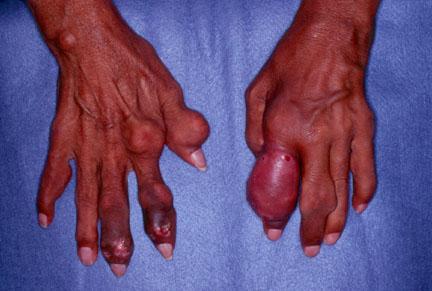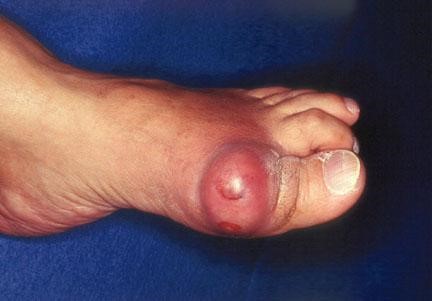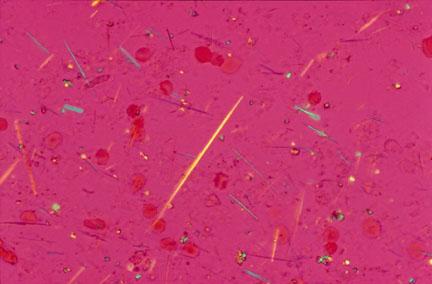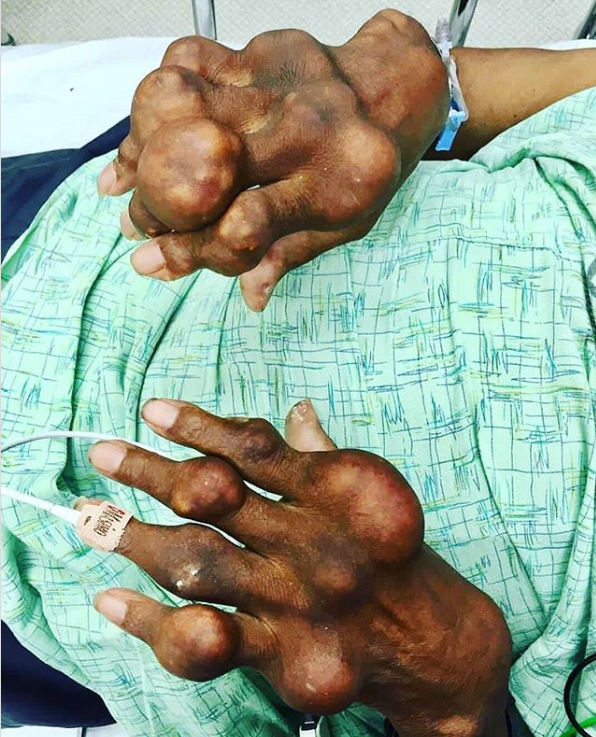The attached image is of the patient with multiple large tophi due to Gouty arthritis.
Gout is a common and painful form of inflammatory arthritis that occurs due to excessive uric acid in the body, called hyperuricemia.
Uric acid is formed in the body by the breakdown of purines which occur naturally in the body and also contained in certain foods. Uric acid can build up either due to increased production or decreased excretion, so any defect in the activity of the enzyme Hypoxanthine Guanine Phosphoribosyl Transferase, increased breakdown of cells, high cell turnover, renal diseases, NSAIDs and diuretic use can lead to gout. Therefore, patients with haematological malignancies, chronic hemolysis and those undergoing chemotherapy are more susceptible.
As the level of uric acid rises, the body tries to wash it off through the kidneys but after a threshold, the kidneys cannot excrete the excess, eventually leading to the formation of urate crystals in or around the joints, particularly in the synovium i.e. the joint lining. The crystals may also form and deposit under the skin, in the tissues and in the internal organs like kidney.

Having said that, some people with high uric acid levels: hyperuricemia, may not have crystal formations and no symptoms at all. Some may have the crystals but no symptoms which is then called asymptomatic gout.
Usually, the urate crystals form in the big toe of the feet. Other joints such as wrists, ankles, metacarpophalangeal, interphalangeal joints, etc. are also commonly involved.
Acute gout occurs when the buildup of urate crystals causes the affected joint to get red, warm, and inflamed with intense pain, often at night. The joint may get tender enough to wake up the patient from sleep. Even a slight touch of a quilt on the inflamed joint can elicit extreme pain and tenderness. The pain gets worse over the next 8 to 12 hours and may take 10 days to resolve. Severe gout may affect multiple joints and may cause joint deformity and tophi formation over time, as seen in the case above.

Risk Factors:
- Male gender
- Obesity
- Hypertension
- Renal diseases
- Water pills/ diuretics
- Alcohol
- Purine-rich foods such as red meat, fish, mussels, tuna, etc.
- Metabolic syndrome
Diagnosis of gout can be made on clinical grounds, further backed up by high serum uric acid levels and imaging studies such as joint Xray, ultrasound and CT scan to look for joint and tissue damage. Joint aspiration can be done for synovial fluid analysis, which in case of gout would reveal needle-shaped, negatively birefringent urate crystals.

For acute gout, indomethacin, an NSAID, is the first line of treatment. NSAIDs should be avoided in patients who are prone to gastritis like ICU patients, or those with peptic ulcer disease. NSAIDs use is also contraindicated in patients with renal insufficiency. In such patients, colchicine or corticosteroids come to the rescue.
Urate lowering drugs such as Allopurinol and febuxostat are given in chronic gout to prevent an acute flare-up by reducing the production, hence the build-up. Whereas uricosuric drugs like probenecid, sulfinpyrazone, etc. help with the excretion.
Other than medicines, patients are advised to maintain a healthy weight and exercise regularly with less strain on the affected joint. Very severe joint deformities may warrant joint replacement surgery.
FACT:
How to treat an incidental finding of high uric acid?
Asymptomatic hyperuricemia, as a general rule, should not be treated.
References
Bruce M Rothschild, M. (2020, February 03). Gout and Pseudogout. Retrieved from Medscape: https://emedicine.medscape.com/article/329958-overview
Gout. (n.d.). Retrieved from Mayoclinic: https://www.mayoclinic.org/diseases-conditions/gout/symptoms-causes/syc-20372897
Gout. (2019, January 28). Retrieved from Centers for disease control and prevention: https://www.cdc.gov/arthritis/basics/gout.html




